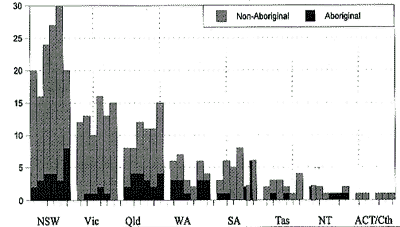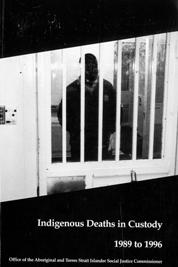Indigenous Deaths in Custody: Chapter 3 Comparison: Indigenous and Non-Indigenous Deaths
Indigenous Deaths in Custody
Part B - Statistical AnalysisChapter 2. Indigenous Deaths in Custody Chapter 3
|
||||||||||||||||||||||||||||||||||||||||||||||||||||||||||||||||||||||||||||||||||||||||||||||||||||||||||||||||||||||||||||||||||||||||||||||||||||||||||||||||||||||||||||||||||||||||||||||||||||||||||||||||||||||||||||||||||||||||||||||||||||||||||||||||||||||||||||||||||||||||||||||||||||||||||||||||||||||||||||||||||||||||||||||||||||||||||||||||||||||||||||||||||||||||||||||||||||||||||||||||||||||||||||||||||||||||||||||||||||||||||||||||||||||||||||||||||||||||||||||||||||||||||||||||||||||||||||||||||||||||||||||||||||||||
| Table 3.1 Death Rate per General Populations | |||||||
| Year |
Adult Populations (15yrs+)* |
Deaths in Custody |
Rate per 100,000 |
Over- representation |
|||
| Aboriginal | Non- Aboriginal | Aboriginal | Non-Aboriginal | Aboriginal | Non-Aboriginal | ||
| 1990 | 168317 | 13141817 |
12 |
54 |
7.1 |
0.4 |
17.3 |
| 1991 | 172462 | 13326044 |
13 |
56 |
7.5 |
0.4 |
17.9 |
| 1992 | 176827 | 13501987 |
9 |
58 |
5.1 |
0.4 |
11.8 |
| 1993 | 181341 | 13649262 |
10 |
70 |
5.5 |
0.5 |
10.8 |
| 1994 | 185836 | 13810095 |
14 |
66 |
7.5 |
0.5 |
15.8 |
| 1995 | 190438 | 13995940 |
22 |
64 |
11.6 |
0.5 |
25.3 |
| Total/Average |
80 |
368 |
7.4 |
0.5 |
16.5 |
||
| * Population figures supplied by the Australian Bureau of Statistics | |||||||
Table 3.A1 in the appendix to this chapter divides the above figures into deaths in police and prison custody. Between 1990 and 1995, Aboriginal people were 14.7 times more likely to die in police custody and 17.4 times more likely to die in prison.
Table 3.2 presents the average death rate and over-representation rate for each jurisdiction in the period 1990 to 1995. The over-representation rate is the highest in South Australia, where Indigenous people are 31.7 times more likely to die in custody. The rate is the lowest in Tasmania and the Northern Territory. The other jurisdictions are closer to the national average.
| Table 3.2 Death Rate per General Population by Jurisdiction 1990-1995 | ||||||||||
|
NSW |
VIC |
Qld |
WA |
SA |
TAS |
NT |
ACT/Cth |
Aust |
||
| Deaths | Indigenous |
27 |
6 |
23 |
14 |
12 |
2 |
5 |
0 |
80 |
| Non-Indigenous |
154 |
84 |
71 |
30 |
36 |
16 |
6 |
5 |
368 |
|
| Rate per 100,000 | Indigenous |
8.3 |
7.2 |
7.5 |
7.9 |
14.8 |
5.8 |
3.0 |
0.0 |
7.4 |
| Non-Indigenous |
0.5 |
0.4 |
0.4 |
0.4 |
0.5 |
0.7 |
1.1 |
0.4 |
0.5 |
|
| Over-representation |
17.0 |
18.8 |
16.8 |
20.5 |
31.7 |
7.7 |
2.8 |
0.0 |
16.5 |
|
2. Death Rates per Custodial Population
Table 3.3 shows the rate at which Indigenous and non-Indigenous people died in prison compared to prison populations. Table 3.2 presents the rate of death per 1000 prisoners each year. The average rate of death for the period 1990 to 1995 was 3.38 for Aboriginal people and 2.69 for non-Aboriginal people. Aboriginal prisoners are therefore 1.26 times more likely to die in prison than non-Aboriginal prisoners.
With regard to deaths in police custody, figures on police custody since 1992 are not available. The Australian Institute Criminology will shortly release figures from the 1995 Australian Police Custody Survey. They will also provide information of death rates. 1
| Table 3.3 Death Rate in Prison Custody per Prison Population | |||||||
| Year |
Prisoners |
Deaths in Custody |
Rate per 1000 prison population |
Over- representation |
|||
|
Indigenous |
Non-Indigenous |
Aboriginal |
Non-Aboriginal |
Aboriginal |
Non-Aboriginal |
||
| 1990 |
2041 |
12264 |
6 |
27 |
2.94 |
2.20 |
1.34 |
| 1991 |
2166 |
12855 |
8 |
31 |
3.69 |
2.41 |
1.53 |
| 1992 |
2223 |
13336 |
2 |
34 |
0.90 |
2.55 |
0.35 |
| 1993 |
2416 |
13450 |
7 |
42 |
2.90 |
3.12 |
0.93 |
| 1994 |
2742 |
14302 |
11 |
42 |
4.01 |
2.94 |
1.37 |
| 1995 |
2907 |
14501 |
17 |
42 |
5.85 |
2.90 |
2.02 |
| Total |
14495 |
80708 |
51 |
218 |
3.38 |
2.69 |
1.26 |
3. Age
The average age of Aboriginal people who died in custody is 29.2 years. This is five and half years less than non-Aboriginal people who die in custody who have an average age of 35 years. This difference is statistically significant. 2 This figure reflects the earlier contact of Aboriginal people with the criminal justice system. 3
4. Gender
Female prisoners accounted for 11.3 per cent of Aboriginal deaths in custody but only 5.2 per cent of non-Aboriginal deaths in custody. The difference is statistically significant. 4 This is consistent with the fact that the disproportionate numbers of Aboriginal women is even greater than the disproportionate numbers of Aboriginal men in custody.
| Table 3.4 Gender | ||||
|
Aboriginal |
Non-Aboriginal |
|||
| Male |
71 |
88.8% |
349 |
94.8% |
| Female |
9 |
11.3% |
19 |
5.2% |
| Total |
80 |
100.0% |
368 |
100.0% |
5. Custodial Authority
Table 3.5 illustrates that Aboriginal and non-Aboriginal deaths in police, prison and juvenile detention centres occurred in the same proportion. Deaths in police custody account for 35.0 per cent of Aboriginal deaths and 39.7 per cent of non-Aboriginal deaths in custody. The figures for prison are respectively 63.8 per cent and 59.2 per cent. Juvenile detention centres account for 1.3 per cent and 1.1 per cent of deaths. The differences are not statistically significant. 5 It is important to note that there has been a shift in the types of deaths in police custody. For both groups there has been a decline in the number of deaths in institutional settings and an increase in deaths resulting from police pursuit. 6 This has consequences for recommendations concerning police arrest practices. (See chapter 6.)
| Table 3.5 Custodial Authority | ||||||||
|
Aboriginal |
Non-Aboriginal |
|||||||
|
Police
|
Prison
|
JDC |
Total
|
Police
|
Prison
|
JDC |
Total
|
|
|
1990 |
5
|
6
|
1 |
12
|
26
|
27
|
1 |
54
|
|
1991 |
5
|
8
|
- |
13
|
25
|
31
|
- |
56
|
|
1992 |
7
|
2
|
- |
9
|
24
|
34
|
- |
58
|
|
1993 |
3
|
7
|
- |
10
|
27
|
42
|
- |
69
|
|
1994 |
3
|
11
|
- |
14
|
23
|
42
|
1 |
66
|
|
1995 |
5
|
17
|
- |
22
|
21
|
42
|
2 |
65
|
|
Total |
28
|
51
|
1 |
80
|
146
|
218
|
4 |
368
|
|
% |
35.0%
|
63.8%
|
1.3% |
100%
|
39.7%
|
59.2%
|
1.1% |
100%
|
6. Jurisdiction
Figure 3.2 shows deaths in custody over the last six years for each jurisdiction. Indigenous and non-Indigenous deaths in custody have generally followed a similar pattern. However, in 1995 the proportion of Aboriginal deaths increased in New South Wales, South Australia and Western Australia. In Queensland, there has been an increase in non-Aboriginal deaths in custody while Aboriginal deaths have remained relatively constant.
Figure 3.1 Deaths in Custody by State: 1990-1995
7. Cause of Death
Table 3.6 breaks down causes of death for deaths in police custody. The differences between the three principal causes of death are not statistically significant. 7 The deaths from injury generally resulted police car chases and cases where Aboriginal people were arrested under the presumption of intoxication. Non-Aboriginal people were more likely to die from self-inflicted gunshot, hanging or injury while in police custody.
| Table 3.6 Causes of Death in Police Custody | ||||
| Cause |
Aboriginal |
Non-Aboriginal 8 |
||
|
No. |
% |
No. |
% |
|
| Natural |
6 |
22.2% |
9 |
6.0% |
| Self-Inflicted | ||||
| Hanging/Injury |
2 |
7.4% |
27 |
18.1% |
| Gunshot |
0 |
0.0% |
22 |
14.8% |
| Drugs |
1 |
3.7% |
5 |
3.4% |
| Non-Self-Inflicted | ||||
| Gunshot |
4 |
14.8% |
31 |
20.8% |
| Drugs |
1 |
3.7% |
13 |
8.7% |
| Alcohol |
- |
0.0% |
2 |
1.3% |
| Injury |
14 |
51.9% |
40 |
26.8% |
| Total |
28 |
100.0% |
149 |
100.0% |
Table 3.7 categorises causes of death in prison. Indigenous people were more likely to die from natural causes. Non-indigenous people were more likely to die from drug overdoses and injury. 9
| Table 3.7 Causes of Death in Prison | ||||
| Cause |
Aboriginal |
Non-Aboriginal 10 |
||
|
No. |
% |
No. |
% |
|
| Natural |
24 |
47.1% |
61 |
27.9% |
| Self-Inflicted | ||||
| Hanging/Injury |
24 |
47.1% |
105 |
47.9% |
| Non-Self-Inflicted | ||||
| Gunshot |
- |
0.0% |
2 |
0.9% |
| Drugs |
1 |
2.0% |
25 |
11.4% |
| Alcohol |
- |
0.0% |
1 |
0.5% |
| Injury |
2 |
3.9% |
22 |
10.0% |
| Unknown |
- |
0.0% |
3 |
1.4% |
| Total |
51 |
100.0% |
219 |
100.0% |
In juvenile detention centres, the cause of the sole death of an Indigenous person was injury. The cause of death for three non-Indigenous people was self-inflicted, and one person died from injury.
Appendix
| Table 3.A1 Death Rates per General Population for Police and Prison* | ||||||||||
| * Population figures supplied by the Australian Bureau of Statistics |
ENDNOTES
-
Dalton, V., Brown, M., and D. McDonald, Australian Deaths in Custody and Custody-related Police Operations, 1995, Deaths in Custody Australia Series, Australian Institute of Criminology, No.12, May 1996 (‘AIC, Deaths in Custody 1995, No. 12').
-
t=3.33, df=447, p<.001. The data-set, as in section 3.6, is slightly different as the data was obtained at a later date from the AIC.
-
See chapter 9.
-
x2=4.16 (df=1, p<0.05).
-
A chi-square test of significance was conducted on the total number of Aboriginal and non-Aboriginal deaths between the custodial authorities: c2=0.61 (df=2, p>0.05).
-
See AIC, Deaths in Custody 1995, No. 12, op. cit., atp.8-9.
-
c2= 2.94 (df=2, p>0.22).
-
These figures were obtained just prior to publication. The AIC now reports an extra three deaths in police custody.
-
c2= 10.8 (df=2, p<0.005).
-
These figures were obtained just prior to publication. The AIC now reports an extra death in prison custody.
A Report prepared by the
Office of the Aboriginal and Torres Strait Islander Social Justice Commissioner
for the
Aboriginal and Torres Strait Islander Commission


